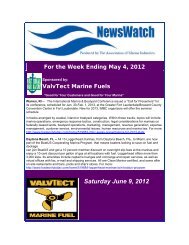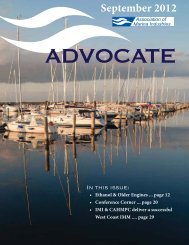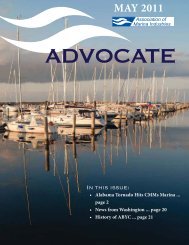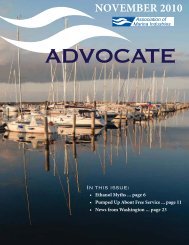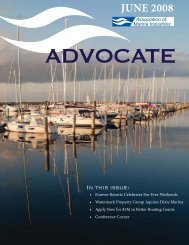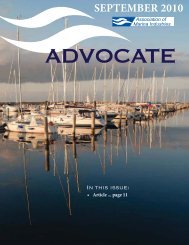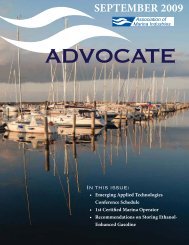Download a copy of AMI's Clean Marina best management practices ...
Download a copy of AMI's Clean Marina best management practices ...
Download a copy of AMI's Clean Marina best management practices ...
Create successful ePaper yourself
Turn your PDF publications into a flip-book with our unique Google optimized e-Paper software.
ATTACHMENT 2 – Oil Spill Contingency Plan and Checklist<br />
An oil spill contingency plan and written commitment <strong>of</strong> resources is required for:<br />
• Flowlines and intra-facility gathering lines at oil production facilities and<br />
• Qualified oil-filled operational equipment which has no secondary containment.<br />
An oil spill contingency plan meeting the provisions <strong>of</strong> 40 CFR part 109, as described below, and a written<br />
commitment <strong>of</strong> manpower, equipment and materials required to expeditiously control and remove any quantity<br />
<strong>of</strong> oil discharged that may be harmful is attached to this Plan.<br />
Ver. 1-E-doc-3-18-10<br />
Complete the checklist below to verify that the necessary operations outlined in 40 CFR part 109 - Criteria for State, Local and Regional<br />
Oil Removal Contingency Plans - have been included.<br />
Table G-15 Checklist <strong>of</strong> Development and Implementation Criteria for State, Local and Regional Oil Removal<br />
Contingency Plans (§109.5) a<br />
(a) Definition <strong>of</strong> the authorities, responsibilities and duties <strong>of</strong> all persons, organizations or agencies which are<br />
to be involved in planning or directing oil removal operations.<br />
(b) Establishment <strong>of</strong> notification procedures for the purpose <strong>of</strong> early detection and timely notification <strong>of</strong> an oil<br />
discharge including:<br />
(1) The identification <strong>of</strong> critical water use areas to facilitate the reporting <strong>of</strong> and response to oil discharges.<br />
(2) A current list <strong>of</strong> names, telephone numbers and addresses <strong>of</strong> the responsible persons (with alternates)<br />
and organizations to be notified when an oil discharge is discovered.<br />
(3) Provisions for access to a reliable communications system for timely notification <strong>of</strong> an oil discharge,<br />
and the capability <strong>of</strong> interconnection with the communications systems established under related oil<br />
removal contingency plans, particularly State and National plans (e.g., NCP).<br />
(4) An established, prearranged procedure for requesting assistance during a major disaster or when the<br />
situation exceeds the response capability <strong>of</strong> the State, local or regional authority.<br />
(c) Provisions to assure that full resource capability is known and can be committed during an oil discharge<br />
situation including:<br />
(1) The identification and inventory <strong>of</strong> applicable equipment, materials and supplies which are available<br />
locally and regionally.<br />
(2) An estimate <strong>of</strong> the equipment, materials and supplies which would be required to remove the maximum<br />
oil discharge to be anticipated.<br />
(3) Development <strong>of</strong> agreements and arrangements in advance <strong>of</strong> an oil discharge for the acquisition <strong>of</strong><br />
equipment, materials and supplies to be used in responding to such a discharge.<br />
(d) Provisions for well defined and specific actions to be taken after discovery and notification <strong>of</strong> an oil<br />
discharge including:<br />
(1) Specification <strong>of</strong> an oil discharge response operating team consisting <strong>of</strong> trained, prepared and available<br />
operating personnel.<br />
(2) Predesignation <strong>of</strong> a properly qualified oil discharge response coordinator who is charged with the<br />
responsibility and delegated commensurate authority for directing and coordinating response operations<br />
and who knows how to request assistance from Federal authorities operating under existing national<br />
and regional contingency plans.<br />
(3) A preplanned location for an oil discharge response operations center and a reliable communications<br />
system for directing the coordinated overall response operations.<br />
(4) Provisions for varying degrees <strong>of</strong> response effort depending on the severity <strong>of</strong> the oil discharge.<br />
(5) Specification <strong>of</strong> the order <strong>of</strong> priority in which the various water uses are to be protected where more<br />
than one water use may be adversely affected as a result <strong>of</strong> an oil discharge and where response<br />
operations may not be adequate to protect all uses.<br />
(6) Specific and well defined procedures to facilitate recovery <strong>of</strong> damages and enforcement measures as<br />
provided for by State and local statutes and ordinances.<br />
a The contingency plan must be consistent with all applicable state and local plans, Area Contingency Plans, and the National<br />
Contingency Plan (NCP)<br />
Facility Name:<br />
Page 14 Tier I Qualified Facility SPCC Plan



